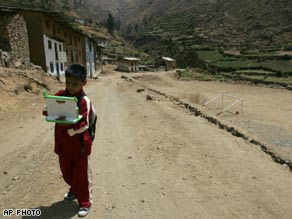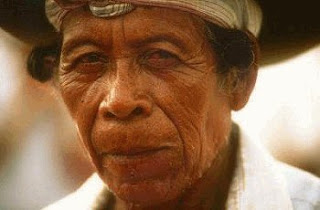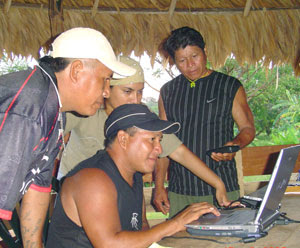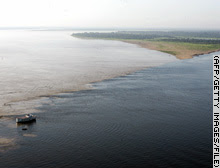 ARAHUAY, Peru (AP) -- Doubts about whether poor, rural children really can benefit from quirky little computers evaporate as quickly as the morning dew in this hilltop Andean village, where 50 primary school children got machines from the One Laptop Per Child project six months ago.
ARAHUAY, Peru (AP) -- Doubts about whether poor, rural children really can benefit from quirky little computers evaporate as quickly as the morning dew in this hilltop Andean village, where 50 primary school children got machines from the One Laptop Per Child project six months ago.These offspring of peasant families whose monthly earnings rarely exceed the cost of one of the $188 laptops -- people who can ill afford pencil and paper much less books -- can't get enough of their "XO" laptops.
At breakfast, they're already powering up the combination library/videocam/audio recorder/music maker/drawing kits. At night, they're dozing off in front of them -- if they've managed to keep older siblings from waylaying the coveted machines. "It's really the kind of conditions that we designed for," Walter Bender, president of the Massachusetts Institute of Technology spinoff, said of this agrarian backwater up a precarious dirt road.
Founded in 2005 by former MIT Media Lab director Nicholas Negroponte, the One Laptop program has retreated from early boasts that developing-world governments would snap up millions of the pint-sized laptops at $100 each.
 In a backhanded tribute, One Laptop now faces homegrown competitors everywhere from Brazil to India -- and a full-court press from Intel Corp.'s more power-hungry Classmate.
In a backhanded tribute, One Laptop now faces homegrown competitors everywhere from Brazil to India -- and a full-court press from Intel Corp.'s more power-hungry Classmate.But no competitor approaches the XO in innovation. It is hard drive-free, runs on the Linux operating system and stretches wireless networks with "mesh" technology that lets each computer in a village relay data to the others.
Mass production began last month and Negroponte, brother of U.S. Deputy Secretary of State John Negroponte, says he expects at least 1.5 million machines to be sold by next November. Even that would be far less than Negroponte originally envisioned. The higher-than-initially-advertised price and a lack of the Windows operating system, still being tested for the XO, have dissuaded many potential government buyers.
Peru made the single biggest order to date -- more than 272,000 machines -- in its quest to turn around a primary education system that the World Economic Forum recently ranked last among 131 countries surveyed. Uruguay was the No. 2 buyers of the laptops, inking a contract for 100,000.
Negroponte said 150,000 more laptops will get shipped to countries including Rwanda, Mongolia, Haiti, and Afghanistan in early 2008 through "Give One, Get One," a U.S.-based promotion ending December 31 in which you buy a pair of laptops for $399 and donate one or both.
The children of Arahuay prove One Laptop's transformative conceit: that you can revolutionize education and democratize the Internet by giving a simple, durable, power-stingy but feature-packed laptop to the worlds' poorest kids.
"Some tell me that they don't want to be like their parents, working in the fields," first-grade teacher Erica Velasco says of her pupils. She had just sent them to the Internet to seek out photos of invertebrates -- animals without backbones.
 Antony, 12, wants to become an accountant.
Antony, 12, wants to become an accountant.Alex, 7, aspires to be a lawyer.
Kevin, 9, wants to play trumpet.
Saida, 10, is already a promising videographer, judging from her artful recording of the town's recent Fiesta de la Virgen.
"What they work with most is the (built-in) camera. They love to record," says Maria Antonieta Mendoza, an Education Ministry psychologist studying the Arahuay pilot to devise strategies for the big rollout when the new school year begins in March.
Before the laptops, the only cameras the kids at Santiago Apostol school saw in this population-800 hamlet arrived with tourists who visit for festivals or to see local Inca ruins. Arahuay's lone industry is agriculture. Surrounding fields yield avocados, mangoes, potatoes, corn, alfalfa and cherimoya.
Many adults share only weekends with their children, spending the work week in fields many hours' walk from town and relying on charities to help keep their families nourished.
When they finish school, young people tend to abandon the village.
Peru's head of educational technology, Oscar Becerra, is betting the One Laptop program can reverse this rural exodus to the squalor of Lima's shantytowns four hours away.
It's the best answer yet to "a global crisis of education" in which curricula have no relevance, he said. "If we make education pertinent, something the student enjoys, then it won't matter if the classroom's walls are straw or the students are sitting on fruit boxes."
Indeed, Arahuay's elementary school population rose by 10 when families learned the laptop pilot was coming, said Guillermo Lazo, the school's director. The XOs that Peru is buying will be distributed to pupils in 9,000 elementary schools from the Pacific to the Amazon basin where a single teacher serves all grades, Becerra said. Although Peru boasts thousands of rural satellite downlinks that provide Internet access, only about 4,000 of the schools getting XOs will be connected, said Becerra.
Negroponte says One Laptop is committed to helping Peru overcome that hurdle. Without Internet access, he believes, the program is incomplete. Teachers will get 2½ days of training on the laptops, Becerra said. Each machine will initially be loaded with about 100 copyright-free books. Where applicable, texts in native languages will be included, he added. The machines will also have a chat function that will let kids make faraway friends over the Internet.
Critics of the rollout have two key concerns.
The first is the ability of teachers -- poorly trained and equipped to begin with -- to cope with profoundly disruptive technology. Eduardo Villanueva, a communications professor at Lima's Catholic University, fears "a general disruption of the educational system that will manifest itself in the students overwhelming the teachers."
To counter that fear, Becerra said the government is offering $150 grants to qualifying teachers toward the purchase of conventional laptops, for which it is also arranging low-interest loans.
The second big concern is maintenance.
For every 100 units it will distribute to students, Peru is buying one extra for parts. But there is no tech support program. Students and teachers will have to do it. "What you want is for the kids to do the repairs," said Negroponte, who believes such tinkering is itself a valuable lesson. "I think the kids can repair 95 percent of the laptops."
Tech support is nevertheless a serious issue in many countries, Negroponte acknowledged in a phone interview. One Laptop is currently bidding on a contract with Brazil's government that Negroponte says demanded unrealistically onerous support requirements.
The XO machines are water resistant, rugged and designed to last five years. They have no fan so they won't suck up dust, are built to withstand drops from a meter and a half and can absorb power spikes typical of places with irregular electricity. Mendoza, the psychologist, is overjoyed that the program stipulates that kids get ownership of the laptops. Take Kevin, the aspiring trumpet player.
Sitting in his dirt-floor kitchen as his mother cooks lunch, he draws a soccer field on his XO, then erases it. Kevin plays a song by "Caliente," his favorite combo, that he recorded off Arahuay's single TV channel. He shows a reporter photos he took of him with his 3-year-old brother.
A bare light bulb hangs by a wire from the ceiling. A hen bobs around the floor. There are no books in this two-room house. Kevin's parents didn't get past the sixth grade.
Indeed, the laptop project also has adults in its sights.
Parents in Arahuay are asking Mendoza, the visiting psychologist, what the Internet can do for them. Among them is Charito Arrendondo, 39, who sheds brief tears of joy when a reporter asks what the laptop belonging to ruddy-cheeked Miluska -- the youngest of her six children -- has meant to her. Miluska's father, it turns out, abandoned the family when she was 1.
"We never imagined having a computer," said Arrendondo, a cook. Is she afraid to use the laptop, as is typical of many Arahuay parents, about half of whom are illiterate? "No, I like it. Sometimes when I'm alone and the kids are not around I turn it on and poke around." Arrendondo likes to play checkers on the laptop. "It's also got chess, which I sort of know," she said, pausing briefly. "I'm going to learn."












